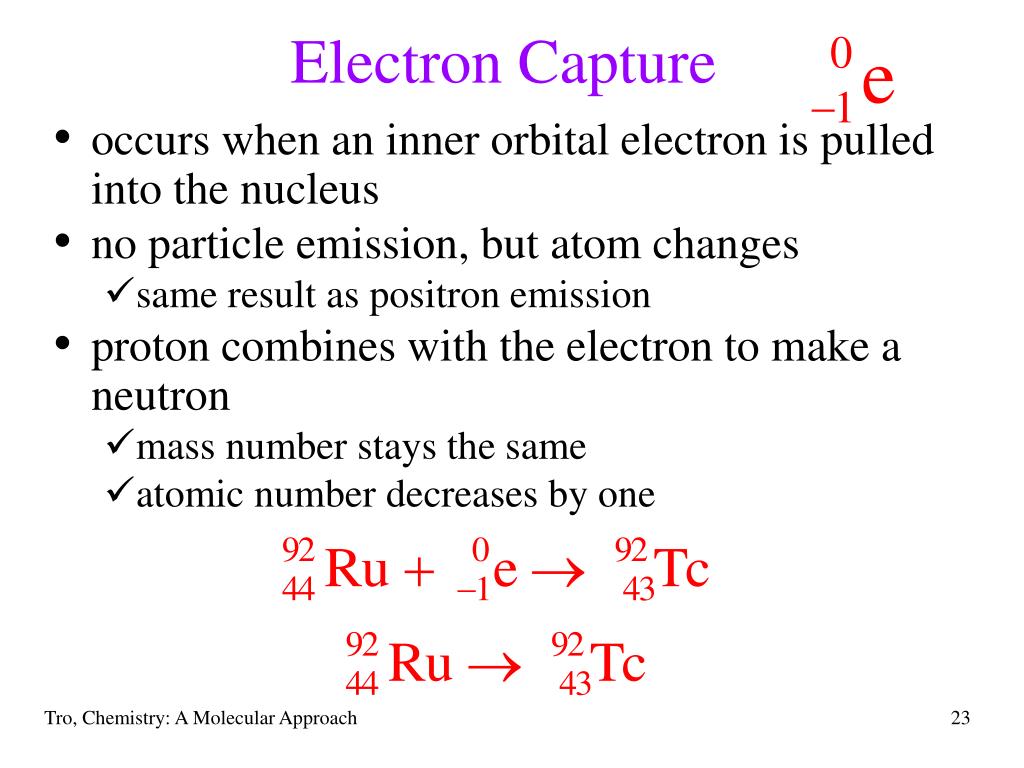
All signals from the detector were recorded over a period of more than one year, however, without looking at them at all as the experiment was conducted in a “blind” fashion. The energy released in the decay was derived from the strength of the two signals. Scientists used this interval and the information provided by the sensors measuring the signals to reconstruct the position of the double electron capture. The time difference between the two signals corresponds to the time it takes the electrons to reach the top of the detector. The electrons were moved towards the gas-filled upper part of the detector where they generated a second light signal.
#EXAMPLE OF ELECTRON CAPTURE FREE#
This is how the XENON collaboration succeeded with this measurement: The X-rays from the double electron capture in the liquid xenon produced an initial light signal as well as free electrons. The peak at 64keV from double electron capture of Xenon-124 is clearly visible in this plot of the background spectrum from XENON1T. However, these signals are very hard to detect, as double electron capture is a very rare process which is hidden by signals from the omnipresent natural radioactivity. The energy released in this process is carried away by X-rays and so-called Auger electrons. The other atomic electrons reorganize themselves to fill in the two holes in the innermost shell. In double electron capture, two protons in the nucleus simultaneously “catch” two electrons from the innermost atomic shell, transform into two neutrons, and emit two neutrinos. Xenon-124, for example, has 54 protons and 70 neutrons. To understand this process, one should know that an atomic nucleus normally consists of positively charged protons and neutral neutrons, which are surrounded by several atomic shells occupied by negatively charged electrons. The new study shows that the XENON1T detector is also able to measure other rare physical phenomena, such as double electron capture. X-rays are emitted when the electron vacancies are subsequently filled. In double electron capture, two electrons and two protons simultaneously convert into two neutrons and two neutrinos. The same sensors also detect a minute amount of electrical charge which is released by the collision process.

This leads to the emission of faint signals of ultraviolet light which are detected by means of sensitive light sensors located in the upper and lower parts of the cylinder.

When a dark matter particle interacts with a xenon atom, it transfers energy to the atomic nucleus which subsequently excites other xenon atoms. This assumption is fundamental to the working principle of the XENON1T detector: its central part consists of a cylindrical tank of about one meter in length filled with 3,200 kilograms of liquid xenon at a temperature of –95° C. Theoretical considerations predict that dark matter should very rarely “collide” with the atoms of the detector. The Gran Sasso Laboratory of the National Institute for Nuclear Physics (INFN) in Italy, where scientists are currently searching for dark matter particles is located about 1,400 meters beneath the Gran Sasso massif, well protected from cosmic rays which can produce false signals. The results were published in the science journal “Nature”. XENON1T is a joint experimental project of about 160 scientists from Europe, the US and the Middle East. In addition, the new result provides information for further investigations on neutrinos, the lightest of all elementary particles whose nature is still not fully understood. Christian Weinheimer from the University of Münster (Germany) whose group lead the study. “The fact that we managed to observe this process directly demonstrates how powerful our detection method actually is – also for signals which are not from dark matter,” says Prof. This makes the observed radioactive decay, the so-called double electron capture of Xenon-124, the rarest process ever seen happening in a detector. The half-life measured for Xenon-124 is about one trillion times longer than the age of the universe. The half-life of a process is the time after which half of the radioactive nuclei present in a sample have decayed away. Using our XENON1T detector at the INFN Gran Sasso National Laboratory, we were able to observe the decay of Xenon-124 atomic nuclei for the first time.

There are radioactive nuclei that wdecay on much longer time scales. An inconceivable length of time by human standards – yet compared to some physical processes, it is but a moment. The universe is almost 14 billion years old.


 0 kommentar(er)
0 kommentar(er)
